Peugeot Bipper 2010.5 Owner's Guide
Manufacturer: PEUGEOT, Model Year: 2010.5, Model line: Bipper, Model: Peugeot Bipper 2010.5Pages: 166, PDF Size: 4.22 MB
Page 21 of 166

24
Instruments and controls
Warning lamp
is indicates Solution - action
Sidelamp on. a manual selection. Turn the ring on the lighting control stalk to the
first position.
Dipped beam headlamp on. a manual selection.
Turn the ring on the lighting control stalk to the
first position.
Main beam headlamp a pull on the control stalk. Pull the lighting control stalk to return to dippe
d
beam.
Direction indicators flashing with an
audible signal. a change of direction
using the lighting control
stalk, to the left of the
steering wheel. To the Right: press the stalk upwards.
To the Left: press the stalk downwards.
Hazard warning lamps flashing with an
audible signal. the hazard warning lamp
switch, located in the
middle of the dashboard,
has been pressed. The left and right direction indicators, and the
associated warning lamps, flash simultaneously.
Front foglamps on. that the button on the
dashboard has been
pressed. Manual selection.
The fog amps only operate if the sidelamps or
dipped beam headlamps are on.
Rear foglamps on. that the button on the
dashboard has been
pressed. Manual selection. The foglamps only operate
if the dipped beam headlamps are on. When
visibility is normal, please switch the foglamps
off to avoid breaking the law. This lamp is a
bright dazzling red.
Page 22 of 166

25
1
READY TO SET OFF
Instruments and controls
Warning lamp
is indicates Solution - action
Cruise control on. activation of the cruise
control. Manual selection. Chapter 1, "Steering mounted
controls"
Rear parking sensors on, accompanied by
a message in the
screen. a fault with the system. The audible system is not active.
Have it checked as soon as possible by a
PEUGEOT dealer.
Electronic gearbox on, accompanied by
a message in the
screen.
incorrect operation by the
driver.
Start the desired operation again.
� �fl� �a�s�h�i�n�g�,� �a�c�c�o�m�p�a�n�i�e�d�
by an audible signal
and a message in the
screen. a fault with the gearbox.
Have it checked as soon as possible by a
PEUGEOT dealer.
Page 23 of 166
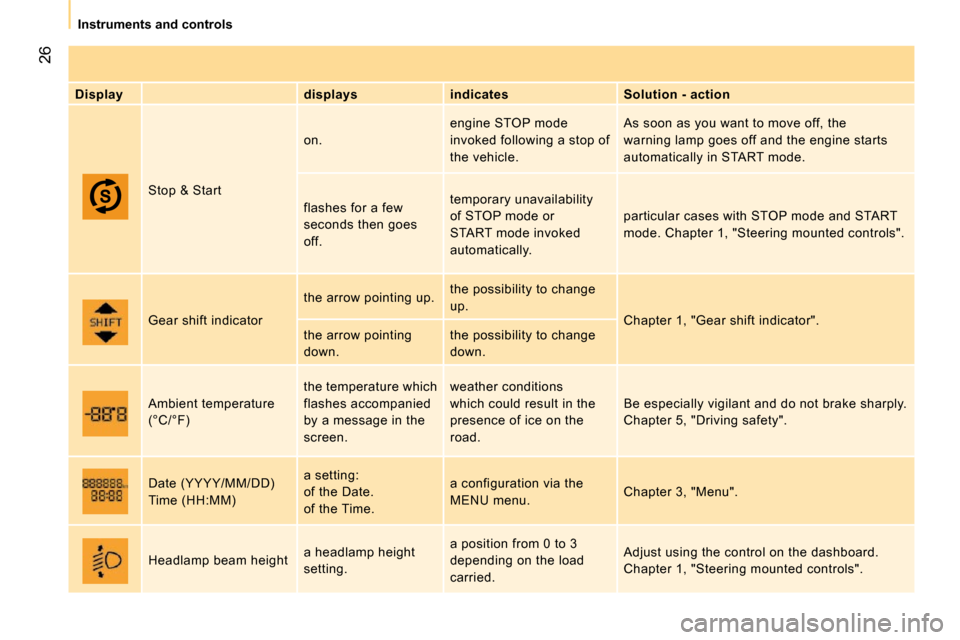
26
Instruments and controls
Display displays indicates Solution - action
Stop & Start on.
engine STOP mode
invoked following a stop of
the vehicle. As soon as you want to move off, the
warning lamp goes off and the engine starts
automatically in START mode.
flashes for a few
seconds then goes
off. temporary unavailability
of STOP mode or
START mode invoked
automatically.
particular cases with STOP mode and START
mode. Chapter 1, "Steering mounted controls".
Gear shift indicator the arrow pointing up.
the possibility to change
up.
Chapter 1, "Gear shift indicator".
the arrow pointing
down. the possibility to change
down.
Ambient temperature
(°C/°F) the temperature which
flashes accompanied
by a message in the
screen. weather conditions
which could result in the
presence of ice on the
road.
Be especially vigilant and do not brake sharply.
Chapter 5, "Driving safety".
Date (YYYY/MM/DD)
Time (HH:MM) a setting:
of the Date.
of the Time. a configuration via the
MENU menu.
Chapter 3, "Menu".
Headlamp beam height a headlamp height
setting. a position from 0 to 3
depending on the load
carried. Adjust using the control on the dashboard.
Chapter 1, "Steering mounted controls".
Page 24 of 166
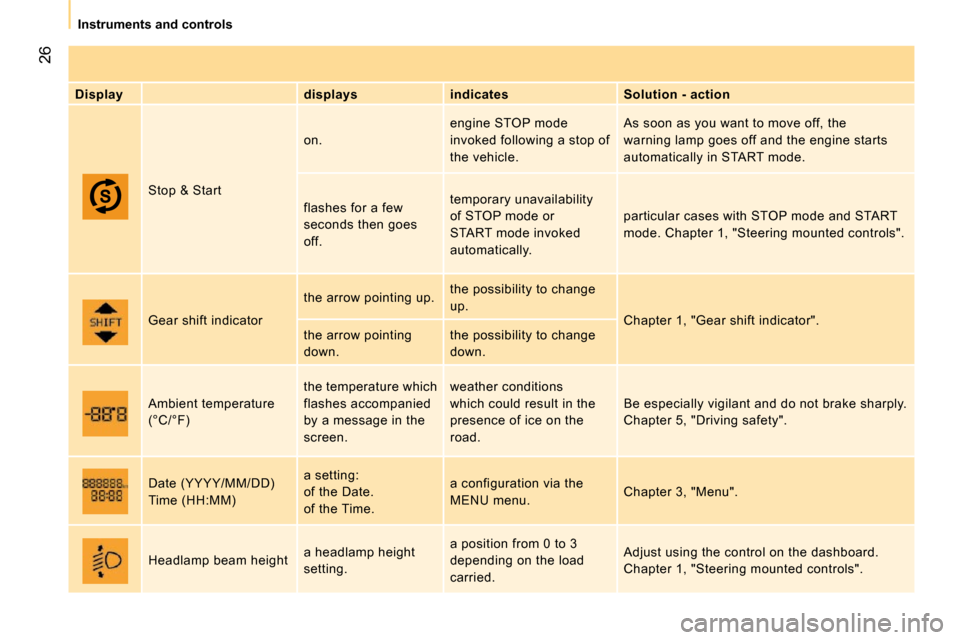
26
Instruments and controls
Display displays indicates Solution - action
Stop & Start on.
engine STOP mode
invoked following a stop of
the vehicle. As soon as you want to move off, the
warning lamp goes off and the engine starts
automatically in START mode.
flashes for a few
seconds then goes
off. temporary unavailability
of STOP mode or
START mode invoked
automatically.
particular cases with STOP mode and START
mode. Chapter 1, "Steering mounted controls".
Gear shift indicator the arrow pointing up.
the possibility to change
up.
Chapter 1, "Gear shift indicator".
the arrow pointing
down. the possibility to change
down.
Ambient temperature
(°C/°F) the temperature which
flashes accompanied
by a message in the
screen. weather conditions
which could result in the
presence of ice on the
road.
Be especially vigilant and do not brake sharply.
Chapter 5, "Driving safety".
Date (YYYY/MM/DD)
Time (HH:MM) a setting:
of the Date.
of the Time. a configuration via the
MENU menu.
Chapter 3, "Menu".
Headlamp beam height a headlamp height
setting. a position from 0 to 3
depending on the load
carried. Adjust using the control on the dashboard.
Chapter 1, "Steering mounted controls".
Page 25 of 166

1
READY TO SET OFF
Instruments and controls
FUEL GAUGE
The fuel level is tested each time the key is
turned to the "ignition on" position.
The gauge is positioned on:
- F (full): the capacity of the fuel tank is
approximately 45 litres .
- E (empty): the reserve is now being
used, the warning lamp comes on
continuously.
The reserve when the warning first comes
on is approximately 6 litres. COOLANT TEMPERATURE
The needle is positioned between
C (cold) and H (hot): normal operation.
In arduous conditions of use or hot climatic
conditions, the needle may move close to
the red graduations. - wait approximately 15 minutes to allow
the engine to cool down in order to check
the level and top it up if necessary. The
cooling system is pressurised. In order to
avoid any risk of scalding, unscrew the
cap by two turns to allow the pressure to
drop.
When the pressure has dropped, check the
level and remove the cap to top up.
If the needle remains in the red zone,
contact a PEUGEOT dealer. EMISSION CONTROL
EOBD (European On Board Diagnosis) is a
diagnostics system which meets the exhaust
emissions standards for:
- CO (carbon monoxide),
- HC (unburnt hydrocarbons),
- NOx (nitrous oxides) or particles detected by oxygen sensors placed upstream and
downstream of the catalytic converters.
Refer to the "Levels" section of chapter 7. Refer to the "Levels" section of chapter 7.
The driver is warned of any
fault with this emission control
system by flashing of this specific
warning lamp in the instrument
panel.
What you should do if the needle
enters the red zone, or if the warning
lamp comes on:
- stop immediately, switch off the ignition. The cooling fan may continue to operate
for a certain time up to approximately
10 minutes.
Page 26 of 166
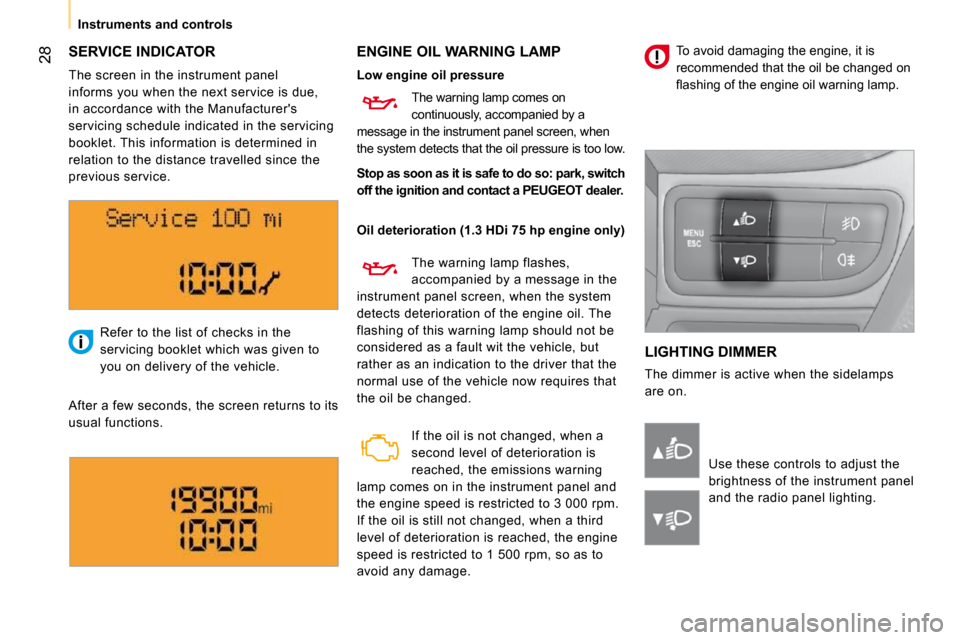
28
Instruments and controls
SERVICE INDICATOR ENGINE OIL WARNING LAMP
LIGHTING DIMMER
The dimmer is active when the sidelamps
are on.
Refer to the list of checks in the
servicing booklet which was given to
you on delivery of the vehicle.
After a few seconds, the screen returns to its
usual functions.
Use these controls to adjust the
brightness of the instrument panel
and the radio panel lighting.
The screen in the instrument panel
informs you when the next service is due,
in accordance with the Manufacturer's
servicing schedule indicated in the servicing
booklet. This information is determined in
relation to the distance travelled since the
previous service.
Low engine oil pressure
Oil deterioration (1.3 HDi 75 hp engine only)
The warning lamp comes on
continuously, accompanied by a
message in the instrument panel screen, when
the system detects that the oil pressure is too low .
The warning lamp flashes,
accompanied by a message in the
instrument panel screen, when the system
detects deterioration of the engine oil. The
flashing of this warning lamp should not be
considered as a fault wit the vehicle, but
rather as an indication to the driver that the
normal use of the vehicle now requires that
the oil be changed.
If the oil is not changed, when a
second level of deterioration is
reached, the emissions warning
lamp comes on in the instrument panel and
the engine speed is restricted to 3 000 rpm.
If the oil is still not changed, when a third
level of deterioration is reached, the engine
speed is restricted to 1 500 rpm, so as to
avoid any damage. To avoid damaging the engine, it is
recommended that the oil be changed on
�fl� �a�s�h�i�n�g� �o�f� �t�h�e� �e�n�g�i�n�e� �o�i�l� �w�a�r�n�i�n�g� �l�a�m�p�.� � �
Stop as soon as it is safe to do so:
park, switch
off the ignition and contact a
PEUGEOT
dealer.
Page 27 of 166
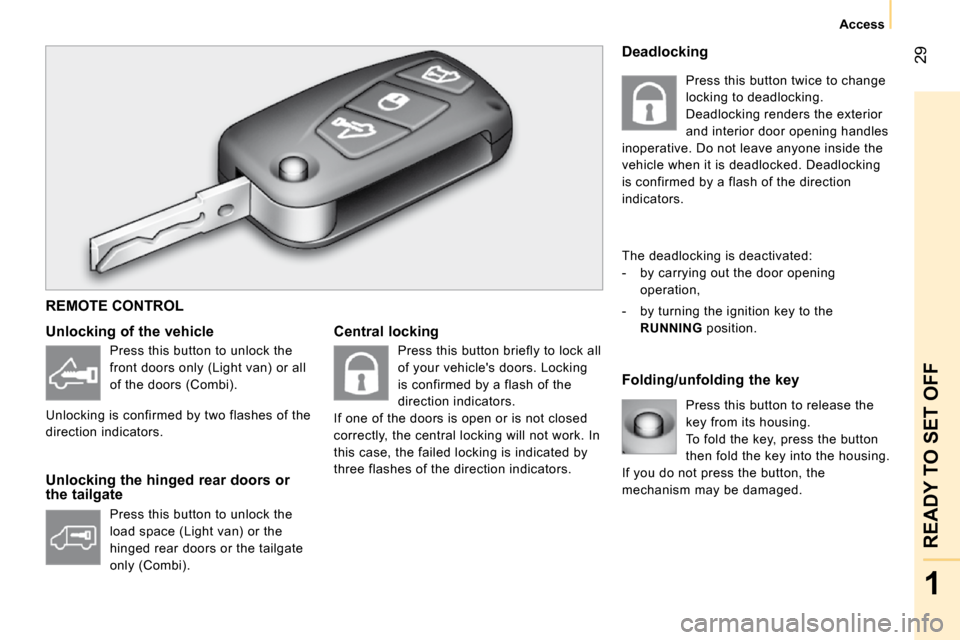
29
1
READY TO SET OFF
Access
Central locking Folding/unfolding the key
Unlocking of the vehicle
Unlocking the hinged rear doors or
the tailgate Press this button to release the
key from its housing.
To fold the key, press the button
then fold the key into the housing.
If you do not press the button, the
mechanism may be damaged.
Deadlocking
The deadlocking is deactivated:
- by carrying out the door opening
operation,
- by turning the ignition key to the
RUNNING position.
REMOTE CONTROL
Press this button to unlock the
front doors only (Light van) or all
of the doors (Combi).
Unlocking is confirmed by two flashes of the
direction indicators.
Press this button to unlock the
load space (Light van) or the
hinged rear doors or the tailgate
only (Combi). Press this button briefly to lock all
of your vehicle's doors. Locking
is confirmed by a flash of the
direction indicators.
If one of the doors is open or is not closed
correctly, the central locking will not work. In
this case, the failed locking is indicated by
three flashes of the direction indicators. Press this button twice to change
locking to deadlocking.
Deadlocking renders the exterior
and interior door opening handles
inoperative. Do not leave anyone inside the
vehicle when it is deadlocked. Deadlocking
is confirmed by a flash of the direction
indicators.
Page 28 of 166

Access
Opening the windows with the remote
control
Closing the windows using the remote
control When closing the windows using the
remote control you must ensure that
nothing prevents their correct closing. The
anti-pinch function does not operate when
closing the windows this way.
If you want to leave the windows partly
open, it is necessary to deactivate the
volumetric alarm monitoring.
Pressing and holding this button
for more than 3 seconds starts
opening of the windows. Release
the button once the windows are
in the desired position. The windows stop as
soon as you release the button.
This closing operation can also be carried
out by inserting and turning the key in the
front door lock barrel.
This opening operation can also be carried
out by inserting and turning the key in the
front door lock barrel.
Pressing and holding this button
for more than 3 seconds starts
closing of the windows. Release
the button once the windows are
in the desired position. The windows stop as
soon as you release the button.
Page 29 of 166
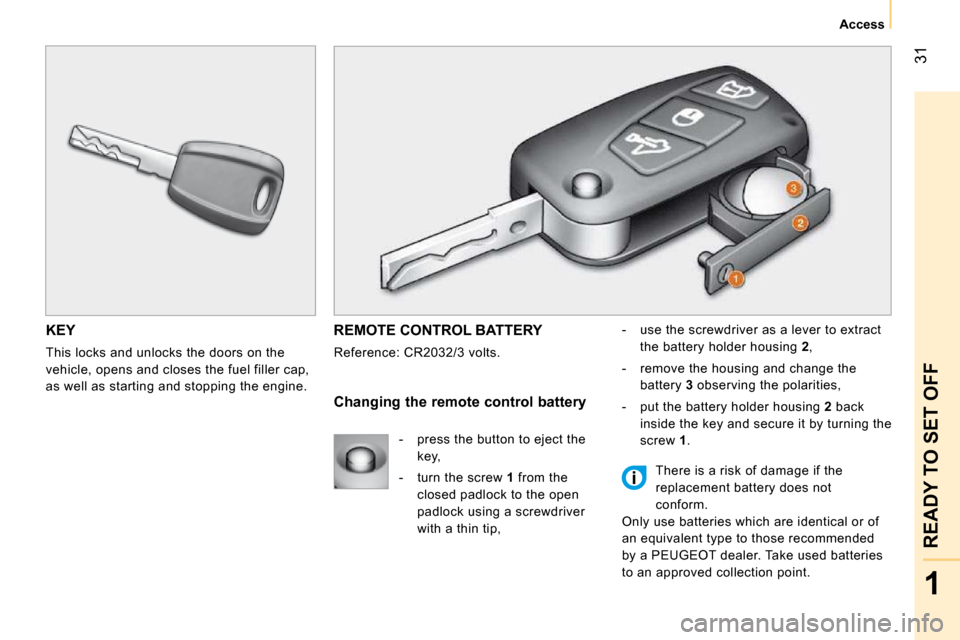
31
1
READY TO SET OFF
Access
KEY
This locks and unlocks the doors on the
vehicle, opens and closes the fuel filler cap,
as well as starting and stopping the engine.
REMOTE CONTROL BATTERY
Reference: CR2032/3 volts. -
use the screwdriver as a lever to extract
the battery holder housing
2 ,
-
remove the housing and change the
battery 3 observing the polarities,
-
put the battery holder housing 2 back
inside the key and secure it by turning the
screw 1 .
Changing the remote control battery
There is a risk of damage if the
replacement battery does not
conform.
Only use batteries which are identical or of
an equivalent type to those recommended
by a PEUGEOT dealer. Take used batteries
to an approved collection point.
- press the button to eject the
key,
- turn the screw 1 from the
closed padlock to the open
padlock using a screwdriver
with a thin tip,
Page 30 of 166
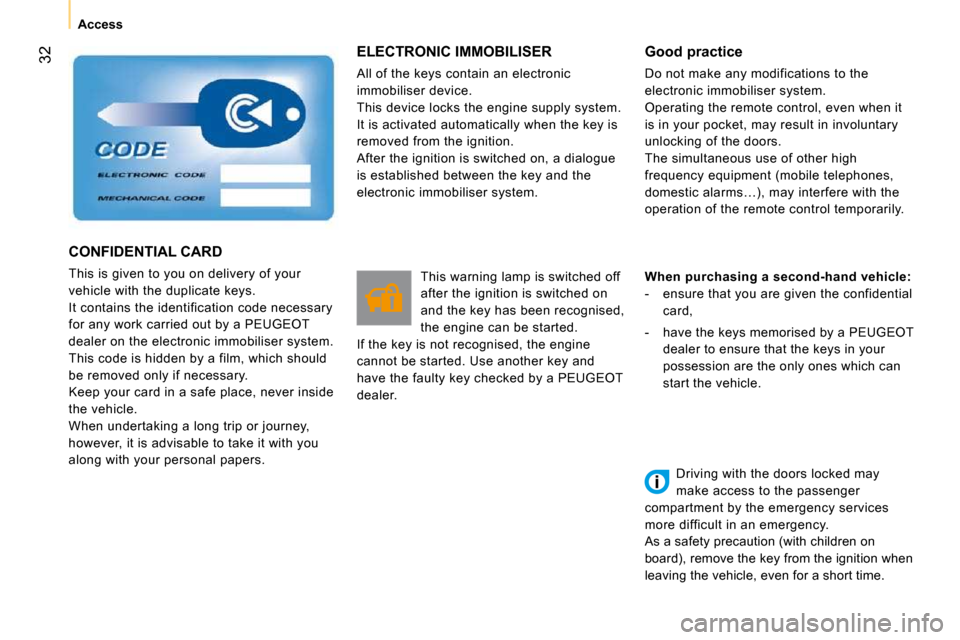
32
Access
ELECTRONIC IMMOBILISER
All of the keys contain an electronic
immobiliser device.
This device locks the engine supply system.
It is activated automatically when the key is
removed from the ignition.
After the ignition is switched on, a dialogue
is established between the key and the
electronic immobiliser system. This warning lamp is switched off
after the ignition is switched on
and the key has been recognised,
the engine can be started.
If the key is not recognised, the engine
cannot be started. Use another key and
have the faulty key checked by a PEUGEOT
dealer. Good practice
Do not make any modifications to the
electronic immobiliser system.
Operating the remote control, even when it
is in your pocket, may result in involuntary
unlocking of the doors.
The simultaneous use of other high
frequency equipment (mobile telephones,
domestic alarms…), may interfere with the
operation of the remote control temporarily.
When purchasing a second-hand vehicle:
- ensure that you are given the confidential card,
- have the keys memorised by a PEUGEOT dealer to ensure that the keys in your
possession are the only ones which can
start the vehicle.
CONFIDENTIAL CARD
This is given to you on delivery of your
vehicle with the duplicate keys.
It contains the identification code necessary
for any work carried out by a PEUGEOT
dealer on the electronic immobiliser system.
This code is hidden by a film, which should
be removed only if necessary.
Keep your card in a safe place, never inside
the vehicle.
When undertaking a long trip or journey,
however, it is advisable to take it with you
along with your personal papers. Driving with the doors locked may
make access to the passenger
compartment by the emergency services
more difficult in an emergency.
As a safety precaution (with children on
board), remove the key from the ignition when
leaving the vehicle, even for a short time.